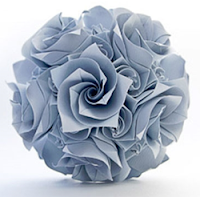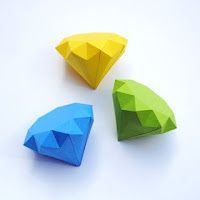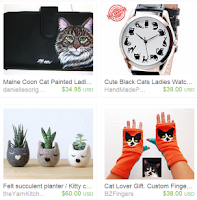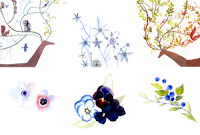#jewelleryfacts365 213/365 Gem fact
In the ancient Persian Empire, the sky-blue gemstones were earlier worn round the neck or wrist as protection against unnatural death. If they changed colour, the wearer was thought to have reason to fear the approach of doom. Meanwhile, it has been discovered that the turquoise certainly can change colour, but that this is not necessarily a sign of impending danger. The change can be caused by the light, or by a chemical reaction brought about by cosmetics, dust or the acidity of the skin.
 |
| Vintage persian turquoise tiara |
Labels:
gem facts,
jewellery facts
Jewellery masterpieces
Tuesday, August 30, 2016
 |
| Antique gold and gem set pendant with a flamenco dancer by Fuset y Grau, Barcelona c.1910 |
Labels:
Jewellery masterpieces
#jewelleryfacts365 212/365 Gem fact
Widely seen as a geological phenomenon, tanzanite formed in the earth's surface over 585 million years ago.
 |
| Tanzanite rough stone and cut stone |
Labels:
gem facts,
jewellery facts
#jewelleryfacts365 211/365 Gem fact
What is widely known as onyx is actually black chalcedony, a variety of quartz.
Labels:
gem facts,
jewellery facts
#jjewelleryfacts365 210/365 Emerald fact
The earliest reference to emeralds in Western literature come from Aristotle. He was a great fan of the gemstone and wrote that owning an emerald increases the owner’s importance in presence and speech during business, gives victory in trials, helps settle litigation, and comforts and soothes eyesight. (source)
 |
| Sterling silver maple leaf earrings with emeralds |
Labels:
emerald facts,
jewellery facts
Bead Day
Saturday, August 27, 2016
 |
| French beaded tulle evening dress, 1930s, from the Vintage Textile archives |
Labels:
Bead Day
#jewelleryfacts365 209/365
For the most part, "estate" means "previously owned". Although, on occasion, a jeweler will close their shop and have never worn pieces of jewelry of other eras that simply did not sell because they were hidden in a drawer or kept in the vault. By the same token, new pieces of jewelry have recently appeared in some auctions and been referred to as "estate" to when it would not be accurate to describe them in that manner.
 |
| VICTORIAN pietra dura pendant 9k gold |
Labels:
jewellery facts
#jewelleryfacts365 208/365 Silver fact
People who have problems wearing silver jewelry are usually allergic to the copper or nickel in the alloyed metal, not the silver. The same goes for the gold alloys.
 |
| Sterling silver earrings with copper peacock feathers |
Labels:
jewellery facts,
silver facts
Jewellery masterpieces
Thursday, August 25, 2016
 |
| George Pragnell Falcon Ring |
Labels:
Jewellery masterpieces
#jewelleryfacts365 207/365 Ancient Egyptian jewellery fact
Labels:
Ancient Egypt facts,
jewellery facts
#jewelleryfacts365 206/365 Copper fact
Gold and copper were the first metals ever discovered around 5000 BC and are the only two metals that are not white/grey in color.
 |
| Silver and copper deer bracelet (gems: peridot, topaz and amethyst) |
Labels:
copper fact,
jewellery facts
Jewellery masterpieces
Tuesday, August 23, 2016
 |
| "The Queen" Garen Garibian Los Angeles, CA, USA |
Labels:
Jewellery masterpieces
#jewelleryfacts365 205/365 Silver fact
The term 'sterling silver' in reference to the grade .925 silver emerged in England in the 13th century.
 |
| Sterling silver earrings |
Labels:
jewellery facts,
silver facts
#jewelleryfacts365 204/365 Pearl fact
Natural (or wild) pearls, formed without human intervention, are very rare. Many hundreds of pearl oysters or mussels must be gathered and opened, and thus killed, to find even one wild pearl; for many centuries, this was the only way pearls were obtained, and why pearls fetched such extraordinary prices in the past.
 |
| Silver pendant with fresh water pearls |
Labels:
jewellery facts,
pearl facts
#jewelleryfacts365 203/365 Gold fact
Most western economies' currencies were on the gold standard until 1961. Switzerland was the last country whose currency was tied to gold. 40% of a Swiss Franc was backed by gold until Switzerland joined the IMF in 1999.
Labels:
gold facts,
jewellery facts
Bead Day
Saturday, August 20, 2016
Labels:
Bead Day
#jewelleryfacts365 202/365 Gold fact
A gold nugget found in the earth can be three to four times as valuable as the gold it contains because of its rareness.
 |
| The Museum of Natural History, Vienna |
Labels:
gold facts,
jewellery facts
#jeweleryfacts365 201/365 Diamond fact
Brown-colored diamonds constituted a significant part of the diamond production, and were predominantly used for industrial purposes. They were seen as worthless for jewelry (not even being assessed on the diamond color scale). After the development of Argyle diamond mine in Australia in 1986, and marketing, brown diamonds have become acceptable gems. The change was mostly due to the numbers: the Argyle mine, with its 35,000,000 carats (7,000 kg) of diamonds per year, makes about one-third of global production of natural diamonds; 80% of Argyle diamonds are brown.
 |
| The open pit of the Argyle diamond mine. A large mining truck is visible on the road for scale. |
Labels:
diamond facts,
jewellery facts
Jewellery masterpieces
Thursday, August 18, 2016
 |
| Mellerio dits Meller, 19 century |
Labels:
Jewellery masterpieces
#jewelleryfacts365 200/365 Roman jewellery fact
Roman jewelry was generally made of gold rather than silver and was decorated with a variety of Precious and Semi-Precious Stones. The precious and semi-precious stones used in the making of Roman jewelry included the following: Pearls, Emeralds, Turquoise, Garnets, Carnelian, Chalcedony, Feldspar and Amethyst.
 |
| Roman jewellery |
Labels:
jewellery facts,
Roman jewellery fact
#jewelleryfacts365 199/365 Ancient Egyptian jewellery fact
Amulets were incorporated into Egyptian jewelry or worn as independent pieces. Amulets are charms or talismans believed to either protect the wearer or infuse him with power. Egyptian amulets were carved into various forms and shapes, such as animals, humans, gods and symbols.
 |
| Ancient Egyptian amulets |
Labels:
Ancient Egypt facts,
jewellery facts
Jewellery maserpieces
Tuesday, August 16, 2016
 |
| Formed of frosted rock crystal flowerheads, each centering a small round diamonds, the leaves of carved nephrite, the stems bound by a double rope of round diamonds, mounted in gold. [source] |
Labels:
Jewellery masterpieces
#jewelleryfacts365 198/365 Diamond fact
Diamonds are extremely hard, but also brittle and can be split up by a single blow. Therefore, diamond cutting is traditionally considered as a delicate procedure requiring skills, scientific knowledge, tools and experience.
Labels:
diamond facts,
jewellery facts
#jewelleryfacts365 197/365 Diamond fact
The production and distribution of diamonds is largely consolidated in the hands of a few key players, and concentrated in traditional diamond trading centers, the most important being Antwerp, where 80% of all rough diamonds, 50% of all cut diamonds and more than 50% of all rough, cut and industrial diamonds combined are handled. This makes Antwerp a de facto "world diamond capital".
Labels:
diamond facts,
jewellery facts
#jewelleryfacts365 196/365 Gold fact
More than 90 percent of all gold ever used has been mined since 1848, when gold was discovered at Sutter's Mill, California, sparking the greatest gold rush of all time.
Labels:
gold facts,
jewellery facts
#jewelleryfacts365 195/365
The Spanish explorers Narváez and De Soto carried glass beads for trade with the native inhabitants of Florida in the early 1500s.
Labels:
jewellery facts
#jewelleryfacts365 194/365
In 2008, Russian archaeologists from the Institute of Archaeology and Ethnology of Novosibirsk, working at the site of Denisova Cave in the Altai Mountains of Siberia, uncovered a small bone fragment from the fifth finger of a juvenile hominin, dubbed the "X woman" (referring to the maternal descent of mitochondrial DNA, or the Denisova hominin. Artifacts, including a bracelet, excavated in the cave at the same level were carbon dated to around 40,000 BC.
Labels:
jewellery facts
Jewellery masterpieces
Thursday, August 11, 2016
 |
| Wendy Yue Titanium Ring Diamond, Radiant Orchid. |
Labels:
Jewellery masterpieces
#jewelleryfacts365 193/365
Elephant ivory is the most important source, but ivory from mammoth, walrus, hippopotamus, sperm whale, killer whale, narwhal and wart hog are used as well. Elk also have two ivory teeth, which are believed to be the remnants of tusks from their ancestors.
 |
| Elk Hair Fork Comb |
Labels:
jewellery facts
#jewelleryfacts365 192/365 Gem fact
Famous jewelry material Black Jet that was popularized during the reign of Queen Victoria is made from fossilized coal formed over 180 million years ago.
 |
| VICTORIAN Whitby jet facet or cant beads, 56" long with faceted graduated beads |
Labels:
gem facts,
jewellery facts
#jewelleryfacts365 191/365 Amber fact
Amber is used as an ingredient in perfumes, as a healing agent in folk medicine, and as jewelry.
Labels:
amber facts
#jewelleryfacts365 190/365 Opal fact
Depending on the conditions in which it formed, opal can take on many colors. Precious opal ranges from clear through white, gray, red, orange, yellow, green, blue, magenta, rose, pink, slate, olive, brown, and black. Of these hues, the black opals are the most rare, whereas white and greens are the most common.
 |
| In November 1917 this mine produced the 1.5 pound precious Roebling Black Opal. The Opal was named after its owner Colonel Washington Augustus Roebling which is in the permanent collection of the same name at the Smithsonian Museum of Natural History. |
Labels:
jewellery facts,
opal facts
#jewelleryfacts365 189/365 Opal fact
The world's largest and most valuable gem opal "Olympic Australis" was found in August 1956 at the "Eight Mile" opal field in Coober Pedy. It weighs 17,000 carats (3450 g) and is 11 in (280 mm) long, with a height of 4.75 in (121 mm) and a width of 4.5 in (110 mm).
 |
| "Olympic Australis" |
Labels:
jewellery facts,
opal facts
Subscribe to:
Posts (Atom)

























































